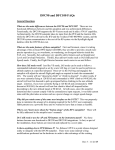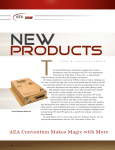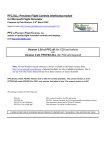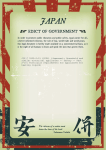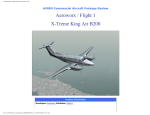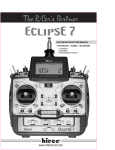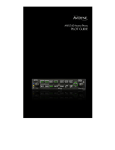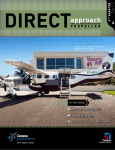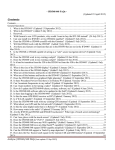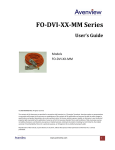Download Avidyne DFC90 Installation manual
Transcript
DFC90 and DFC100 FAQs Updated 26 June 2012 General Questions (DFC90, 100) What are the main differences between the DFC90 and DFC100? There are two functional differences between and the autopilots and two architectural differences. Functionally, the DFC100 supports the R9 Vectors mode and it adds a VNAV capability. Architecturally, the DFC90 autopilot takes its input from the Avidyne or Aspen PFD and the Garmin 430s (or GPS/Nav/Coms connected to the Aspen PFD) while the DFC100 is driven by the IFD and the Avidyne FMS 400/900w system, and the DFC100 system communicates to the rest of the R9 system via the Byteflight digital databus while the DFC90 does not. (updated 17 April 2012) (DFC90, 100) What are the main features of these autopilots? First and foremost, since it is taking advantage of the on-board PFD digital ADAHRS, they are able to provide a much more precise operation (e.g. no overshoots, no wandering, no divergent behavior inside the FAF, etc). Secondly, they add some very specific safety features such as Straight and Level and Envelope Protection. Thirdly, they add new modes such as IAS (Indicated Air Speed) mode. Finally, the Flight Director becomes much easier to use and follow. (DFC90, 100) How does IAS mode work? Just like VS mode, IAS mode can be used to follow a commanded indicated airspeed as set by a new IAS bug or it can be used to perform an altitude capture at a specified airspeed. Once set via the IAS bug and engaged, the autopilot will adjust the aircraft flight path angle as required to track the commanded IAS. The system will not “descend to climb” or “climb to descend”. In other words, if you were currently flying at 120 KIAS and commanded a 1000’ climb at 140 KIAS, the aircraft will not first descend to pick up airspeed before climbing to the new altitude target. Likewise, if you were currently flying at 120 KIAS and commanded a 1000’ descent at 90 KIAS, the aircraft will not first climb to bleed off airspeed before descending to the new altitude target at 90 KIAS. In both cases, since the autopilot determines that it cannot comply with the contradictory input requests, it was hold current state until the pilot takes an action such as a power change or a target speed change. (DFC90, 100) Why did you retain some of the same user interface as the S-TEC? This was purposely done to minimize the amount of re-training required for the S-TEC user community since that represented the vast majority of our early customers. Habit patterns are a powerful force and we wanted to leave that as intact as feasible. (updated 24 July 2011) (DFC90, 100) Where can I learn more about the “button-ology” of the DFC autopilots? These are fully addressed in the autopilot user’s manuals. The link for the DFC90 Pilot Guide is here and the link for the DFC100 Pilot Guide is here. Avidyne | DFC90, 100 FAQs (Last updated: 26 June 2012) 1 (DFC90, 100) Do I still need to use the AP and FD buttons on the instrument panel? No, those buttons become non-functional in DFC90 and DFC100 integrations. In fact, as part of the installation for those aircraft that had them, those buttons are removed and replaced by a cover plate. Your installer has the option of either ordering a cover plate from Avidyne as part of the initial order (for black or beige Cirrus instrument panels) or building their own cover plate. (updated 27 Feb 2012) (DFC90) Is there anything else in Avidyne PFD Release 8? No, Release 8 PFD is a point release designed solely to integrate with the DFC90 autopilot. There were some internal wiring modifications performed on the hardware in order to take advantage of the existing aircraft wiring and some associated software modifications to drive the DFC90 and that is all. (DFC90) What is Avidyne PFD Release 8.0.1 and 8.0.2 and 8.0.3 and 8.0.4 and 8.0.5? PFD Release 8.0.1 was the first version of PFD code that was released in conjunction with the DFC90. 8.0.1 did not support the Underspeed portion of Envelope Protection. PFD Release 8.0.2 was the first version of PFD code that allows the Underspeed function to be enabled but this was an installer function. PFD Release 8.0.3 is considered a mandatory update and automatically enables underspeed, thereby eliminating any chance it was not properly enabled. PFD Release 8.0.3 was granted TSO approval in August, 2010. PFD Release 8.0.4 was an interim release designed to help certify DFC90 Release 2. PFD Release 8.0.5 accompanies, and is required to take full advantage of, DFC90 Release 2. We’ve been colloquially calling them all “Release 8”. (updated 19 Dec 2011) (DFC90) What is in DFC90 Release 2? DFC90 Release 2 was certified in December 2011 and includes the following additions or changes: • • • • • • • • Adds support for the Entegra PFD equipped PA46 Matrix and Mirage aircraft; Added support to take flap position input to increase the accuracy of Envelope Protection alerts and behaviors (flap position wiring is optional for Cirrus aircraft but highly recommended and mandatory for all other airframe types); Added full-time Envelope Alerting. This feature provides underspeed, overspeed, excessive bank, and flap overspeed alerting in Flight Director mode and when the autopilot is in standby (AP Ready); Changed system behavior such that if an AHRS-Turn Coordinator Miscompare is observed in-flight, the autopilot will no longer disconnect. The aural and text alerting remain but the autopilot stays connected; Replaced the computer synthesized voice alerts with an actual human recording (her name is Charlotte); Added support for the aftermarket roll servo modification in Cirrus aircraft; Added an alert to notify the pilot if the autopilot has detected that the roll axis servo has reached its maximum limit (“SERVO LIMIT”); Added an alert to notify the pilot if the flaps are being oversped per POH airspeed limits. This comes in the form of an aural alert (“Caution, Flap Overspeed”). This feature requires the optional flap wiring modification; Avidyne | DFC90, 100 FAQs (Last updated: 26 June 2012) 2 • • • • • • Added an alert to notify the pilot if the POH bank angle limit has been exceeded. This comes in the form of an aural alert (“Caution, Excessive Bank”) and a text alert (“BANK LIMIT”); Provides suppression of Underspeed alerting while on short final, in the flare, and during landing rollout. This requires the optional flap wiring modification – we use a combination of flap position, manifold pressure value (if available) and ground speed to determine when to suppress this alert) [Note: This suppression of Underspeed Alerting is not available in SIU-equipped Cirrus aircraft in PFD Release 8.0.5 – it will be added as part of PFD Release 8.0.6 in the summer of 2012]; Removed the engagement limits of the DFC90 such that it can be engaged at any aircraft state. The maximum demonstrated engagement values are listed in the pilot guide; Capped the upper end of the IAS bug to match the autopilot limitation speed (e.g. 185 KIAS in the Cirrus aircraft); Changed the system behavior when on an ILS or WAAS glideslope and the glide slope data is subsequently lost. Now the system will revert to ALT Hold mode after approximately 5 seconds of no glide slope signal; Added support for Control Wheel Steering (CWS). This is not available in all aircraft. PFD Release 8.0.5 or later is required to take advantage of the features and content of DFC90 Release 2. (updated 26 June 2012) (DFC90) Does my current Aspen PFD software load work with the DFC90? You need the Aspen Pilot Pro PFD loaded with software version 2.6 or later and the accompanying DFC90 enablement key for your Aspen PFD to work with the DFC90 autopilot. That Aspen hardware-software combination is to be obtained through normal Aspen sales channels . (added 17 Apr 2012) (DFC100) Is there anything else in IFD Release 9.2.1? Yes, the list includes support for the DFC100, support for ELTs that require GPS position inputs (NMEA-0183), and a list of software issues fixed including missing range to altitude arc, Direct-To guidance, HDI sensitivity in RNAV approaches, Nearest page delay, morse code processing for non-standard VORs and ILSs, some map redraw improvements, and more accurate TOD placement on the map. (DFC100) Are there any autopilot features in IFD Release 9.2.2, 9.2.3, or 9.2.4? Yes, 9.2.3 improved the suppression of Underspeed alerting while on short final, in the flare, and during landing rollout but that also required DFC100 Release 2. IFD Release 9.2.4 improves the suppression of Underspeed alerting in the landing environment even more and also requires to be paired up with DFC100 Release 2 to work . (added 10 Oct 2011) (DFC100) What is in DFC100 Release 2? DFC100 Release 2 was certified in December 2011 and includes the following additions or changes (updated 27 Feb 2012): Avidyne | DFC90, 100 FAQs (Last updated: 26 June 2012) 3 • • • • • • • • • Adds support for the Entegra PFD equipped PA46 Matrix and Mirage aircraft; Changed system behavior such that in single AHRS equipped aircraft, if an AHRS-Turn Coordinator Miscompare is observed in-flight, the autopilot will no longer disconnect. The aural and text alerting remain but the autopilot stays connected; Added support for Control Wheel Steering (CWS) [Not available in all aircraft – requires a cockpit switch to activate]; Added support for Takeoff/Go Around (TOGA) [Not available in all aircraft – requires a cockpit/throttle switch to activate]; Added support for Flight Into Known Icing (FIKI) [Not available in all aircraft]; Added an alert to notify the pilot if the flaps are being oversped per POH airspeed limits. This comes in the form of an aural alert (“Caution, Flap Overspeed”). [requires the optional flap wiring modification]; Provided suppression of Underspeed alerting while on short final, in the flare, and during landing rollout. [requires the optional flap wiring modification – we use a combination of flap position, manifold pressure value (if available) and ground speed to determine when to suppress this alert]; Moves the autopilot disconnect tone off of the SD card so that it is still capable of being heard in the event of a MSR FAIL condition.; Changed the system behavior when on an ILS or WAAS glideslope and the glide slope data is subsequently lost. Now the system will revert to ALT Hold mode after approximately 5 seconds of no glide slope signal. (DFC90, 100) Is there an on/off switch to the DFC autopilots? If not, how do I turn it on? No, there is no on/off switch for the DFC autopilot. It reuses the old autopilot circuit breaker. It powers up when the governing electrical bus is powered. (updated 24 July 2011) (DFC90, 100) How much power/current does the DFC autopilot use? The DFC90/100 pulls 0.25A when no servos are in operation and up to 0.9A with all servos operating at 100% duty cycle. (DFC90, 100) How much does the DFC autopilot weigh? Both the DFC90 and DFC100 autopilots weigh 2 pounds. (updated 24 July 2011) (DFC100) How does VNAV work in the DFC100? There is an in-depth description in the DFC100 Pilot Guide but in short, when in VNAV mode on the DFC100, the autopilot will follow whatever vertical constraints are entered into the FMS400/900W active flight plan. For example, if an approach is loaded in the FMS, any vertical constraints (e.g. step down fixes, “at or above” fix, “at” fix, “at or below” fix) will be automatically loaded into the flight plan and the DFC100 will automatically adjust the aircraft altitude and descent profile to meet those altitude constraints when in VNAV mode. One of the goals of the final system is to be able to enter a flight plan into the FMS and when airborne, press the NAV and VNAV buttons of the autopilot and never have to press any other autopilot buttons for the remainder of the flight until it’s time to disconnect the autopilot. Avidyne | DFC90, 100 FAQs (Last updated: 26 June 2012) 4 (DFC90, 100) Are there any other sources of information where I can learn more about the autopilot products or programs? Avidyne is hosting frequent webinars now on the DFC series of autopilots. Our products page of our website also contains some more information at http://avidyne.com/products/dfc90/index.asp and http://avidyne.com/products/dfc100/index.asp . We also maintain an online forum where more information gets periodically added. This can be accessed at http://avidynelive.com/forum_topics.asp?FID=16&title=dfc90dfc100-digital-autopilot We are also providing occasional Twitter tweets that are providing periodic program and product updates under the Twitter Username “AviJake”. Finally, a number of customer testimonials are being posted at http://www.avidyne.com/landing/dfc90/testimonials.asp Installation Questions (DFC90) What do you expect the DFC90 install time to be for Cirrus-Entegra-S-TEC 55X configurations? Avidyne is estimating 3-5 labor hours for installers to perform the complete install and checkout. The entire installation consists of the removal/replacement of the S-TEC 55X from its tray, replaced by the DFC90 (this takes approximately 5 minutes) and in the case of the DFC90 system, the replacement of the PFD with a DFC-compatible PFD and then a system checkout. Avidyne requires a system checkout to involve a nominal flight test to verify modes in-air. Based on results of the early pilot program, Avidyne has eliminated the mandatory pre-install servo and rigging “goodness” tests. This will eliminate most of the remaining installation time. Those tests are included in the DFC90 install manual in the event the customer or installer elect to perform them anyway. However, as of DFC90 Release 2, Avidyne strongly recommends including the optional wiring of the flap position into the DFC90 autopilot tray. This optional extra step will add time to the labor required for DFC90 installation but will add some very important and useful features to Envelope Protection and Alerting as defined earlier in these FAQs. Estimates of additional labor start with as few as 3-4 extra hours and have ranged up to 8 or greater – you need to check with your install shop for more precise estimates. (updated 10 Oct 2011) (DFC90) What do you expect the DFC90 install time to be for Piper-Entegra-S-TEC 55X configurations? The install time is highly dependent on the installer and the experience they have with installing the DFC90 in Piper aircraft. For the installs performed to date, actual labor hours needed range from 15 hours to approximately 60 hours. (added 17 April 2012) (DFC90) What do you expect the DFC90 install time to be for Baron/Bonanza/Skylane-Aspen configurations? We have not yet compiled any installation estimates but generally speaking, the following tasks will need to be accomplished: Avidyne | DFC90, 100 FAQs (Last updated: 26 June 2012) 5 • • • • • • • Remove all the legacy gear, if not already done so by the Aspen mod (e.g. ADI, HSI, Remote Annunciators, Mode controllers, DGs, Alt/VS Preselectors, etc); Replace the autopilot tray (except for S-TEC 55/55X installations where the tray is reusable); Install the new equipment (e.g. Aspen PFD if required, DFC90 autopilot tray if required, DFC90 flight computer); Install the autopilot harness adaptor (expected to be a plug & play adapter harness that uses the existing autopilot wires/connectors/harness for most airplanes but others will be easier to replace unreliable or poor existing connectors/harnesses with a new one). Note that when replacing an STec 55X, there is no harness adapter required; For aircraft that are replacing a King autopilot with the DFC90, the King servos must be swapped out for the new Avidyne ASA575 servos which are a form-fit replacement for the King servos; Add any supplementary wiring required (e.g. wiring in the flap position); System checkout and paperwork signoff. See http://avidynelive.com for additional details on the installation tasks. (updated 17 April 2012) (DFC90) What are the minimum requirements for installation into Barons/Bonanzas/Skylanes/Matrix/Mirage aircraft? The following set of equipment is required for a successful installation in those aircraft: • An Aspen Pilot Pro or Avidyne PFD; • A pre-existing autopilot from the table on page 14 of these FAQs; • For aircraft with an Avidyne PFD: At least one 430/430W/530/530W or IFD540. We believe the CNX480 will be an acceptable navigator as well but we have not fully verified that in the lab yet; • For aircraft with an Aspen PFD: At least one GPS/Nav/Com that can provide flight plan information and nav radio deviations for instrument approaches; • A functional pitch trim servo; • An unswitched/unmated audio panel (e.g. most Garmins, King, and PS Engineering panels qualify). For those aircraft with no pre-existing autopilot found in the page 14 table, they will first have to install the servos/rigging/harnesses for an acceptable pre-existing autopilot. (updated 17 April 2012) (DFC90) What can be done if I don’t currently have any autopilot installed or not one from the acceptable list in the table listed several pages below? Do you have your own servo solution? We announced our own ASA575 servos at Sun-n-Fun 2012. This means that if you did not have pre-existing functional STec or Century servos that you want to retain in the aircraft, you now have a path to install the Avidyne servos. These ASA575 servos are going through qual and certification during 2012 and are expected to be available in 2013. Note that aircraft with previously installed King servos will need to swap out the King servos for the Avidyne servos when upgrading to a DFC90 autopilot. The Avidyne servos use the same mounting scheme/brackets as the King servos and use Avidyne | DFC90, 100 FAQs (Last updated: 26 June 2012) 6 the same form factor in an effort to minimize costs and installation difficulties. (updated 26 June 2012) (DFC100) What do you expect the DFC100 install time to be in Cirrus aircraft? Avidyne is estimating 8-12 labor hours for installers to perform the complete install and checkout for Cirrus aircraft. The entire installation consists of the removal/replacement of the S-TEC 55X from its tray, replaced by the DFC100 (this takes approximately 5 minutes) and then update the software in the IFDs via the front bezel USB port and then a system checkout. Avidyne requires a system checkout to involve a nominal flight test to verify modes in-air. The other part of the installation is the wiring of the flap switch input to the harness and ensuring that the Byteflight digital Databus wires run into the DFC100 autopilot tray. Depending on the date of your R9 installation, most harnesses are already provisioned for the flap wires. All R9 installations from late-February 2011 and forward will have the full wiring completed as part of the R9 installation. (updated 17 April 2012) (DFC90, 100) What kind of warranty will the DFC autopilot have? How about a Rel 8 PFD? How about a Rel 9.2.4 IFD? The autopilot will have a 2-year warranty following installation and the PFD/IFDs will have a 6-month warranty attached to it if not covered by Flex and 6 months or end of Flex, whichever is longer, if covered by Flex. The warranty registration form must be sent back to Avidyne by the installer to start that two year clock. Until that form is received by Avidyne, the warranty start period is assumed to be the autopilot ship date from the Avidyne factory. (DFC90, 100) Will the DFC autopilot fall under the Platinum Warranty service? Yes, both the DFC autopilot and the upgraded PFD are eligible for Platinum service (DFC90) Is a Rel 8 PFD backward compatible with a S-TEC 55X? Yes it is. Release 8 PFDs will be able to support both the 55X, 55SR, and DFC90 autopilots. (DFC90) Is a Rel 8 PFD backward compatible with other autopilots? No it is not. (added 24 July 2011) (DFC100) Is a Rel 9.2.1 or later IFD backward compatible with a S-TEC 55X? Yes it is. The software in Release 9.2.1 (or later) IFDs will be able to support both the 55X, and DFC100 autopilots but since the autopilot uses different signals on the same pins, there is some wiring changes that mean several hours of labor to convert between the two configurations. (updated 24 July 2011) (DFC90, 100) What happens to the removed autopilot? The removed autopilot is returned to Avidyne as part of the installation process. There is no real market for used autopilots that we are aware of and those autopilots are aircraft make/model specific. For those that insist on hanging onto their removed autopilot, the installer should contact Avidyne Sales directly. (updated 24 July 2011) Avidyne | DFC90, 100 FAQs (Last updated: 26 June 2012) 7 (DFC90, 100) Are there any autopilot calibrations required? No, there are no autopilot calibrations required after installation. This is part of the “digital dividend”. (DFC90, 100) Should I still put in a roll servo in my Cirrus? We understand that a sizeable number of potential Cirrus DFC90 customers have performed the roll servo mod and as of DFC90 Release 2, we have added support for that configuration. For the DFC100, the roll servo has always been supported. Many owners find that the roll trim motors tend to degrade in performance over time and this has a noticeable effect on the autopilot tracking performance. Some owners also find they can inadvertently hit the built-in mechanical limit switch in a roll trim motor thereby affecting the autopilot performance. Both of these possibilities are dramatically reduced in roll servo equipped aircraft. (updated 10 Oct 2011) (DFC90, 100) What if I already had the roll servo upgrade to my Cirrus? For the DFC90 (as of Release 2) and all DFC100 configurations, the installer will merely select that type of servo during the installation process and the DFC100 will be able to take advantage of the benefits the roll servo provides over the roll trim motor. (updated 10 Oct 2011) (DFC90, 100) Do I need to keep the turn coordinator? No, you don’t need to but in the case of single Avidyne (or Aspen) PFD installations in Cirrus or Piper PA-46 that are replacing the S-TEC 55 autopilot, the installation requires the retention of the turn coordinator as an extra comparator since the software and approved STC wiring are already in place. From a regulatory perspective, Change 1 of AC 23.1311-1B does not require the use of an independent attitude source serving as a comparator if the primary AHRS has sufficient self-monitoring and alerting, which both the Avidyne and Aspen systems do. For those systems where an AHRS-TC comparator is currently in operation, the DFC90/100 software was changed in Release 2 such that it will no longer disconnect the autopilot in the event of a miscompare with the turn coordinator. (updated 17 April 2012) (DFC90, 100) How can I be sure the DFC autopilot is right for my aircraft? Avidyne has provided installers with instructions on how to perform a quick check of your aircraft rigging and the servo health to ensure your aircraft is properly configured to take advantage of all that the DFC autopilot has to offer. (updated 24 July 2011) (DFC90) What other kind of installation “gotchas” have you heard about from the field? For aircraft equipped with PFD Release 8.0.2, some installations have neglected to enable Underspeed protection and/or have inadvertently changed the setting for the aircraft reference symbol (“Flying W” or “Delta”) during the PFD software upgrade. Service Information Letter SIL-606-00006-001 dated 29 July 2010 instructs installers on how to avoid this issue. PFD Release 8.0.3 was created in mid-August 2010 to ensure Underspeed is always enabled in DFC90 equipped aircraft. Avidyne | DFC90, 100 FAQs (Last updated: 26 June 2012) 8 Also, some installers are finding that the rubber gasket in some existing S-Tec 55X trays prevents, or makes challenging, a solid connection at the pins. The Avidyne STC was modified to allow installer removal of the rubber gasket should it be present and causing a connection problem. There have also been a few examples of installers performing an autopilot calibration (AP Cal) following installation of the DFC90. This AP Cal is not supposed to be conducted for the DFC90 and is only applicable for STec 55X installs. Performing this STec 55X Flight Director/Autopilot calibration on a DFC90 installation will result in improper DFC90 behavior. There have been a small handful of reports of lateral oscillation after a DFC90 installation in Cirrus aircraft and to date, each report has been traced to “stiction” in the flight control surfaces or a bad roll-axis servo or a bad aileron interconnect bungee (the most likely cause) or a mis-bent trim tab. The DFC90 Installation Manual does contain some tests to determine if this is case in an individual aircraft. There have also been a handful of reports of pitch porpoising after a DFC90 installation in Cirrus aircraft. So far, every one of these reports has been traced to an out-of-spec pitch servo. Release 2 added the “SERVO LIMIT” message capability to the system which indicates the roll trim cartridge has been fully compressed and is at it’s limit for some reason. There are some reports from customers now seeing this message – if you do see, Avidyne recommends you contact a service center to determine why. Common reasons are unnecessary pilot input on the flight controls, a bad roll trim cartridge itself, bad aileronrudder interconnect bungee, a mis-rigged aircraft trim tab(s). For non-primary engine (“SIU-equipped) Cirrus aircraft who upgraded/installed PFD Rel 8.0.5 and DFC90 Rel 2, SIL 606-00006-002, dated 26 June 2012 describes a condition where Underspeed Alerts are not suppressed in the landing phase, potentially resulting in nuisance alerts. Details, options and intended resolution are provided in the SIL which can be found at http://www.avidyne.com/support/downloads/index.asp (updated 26 June 2012) (DFC100) What other kind of installation “gotchas” have you heard about from the field? None so far but some customers and installers are initially surprised to learn of the wiring steps described above on page 3 of these FAQs. Avidyne | DFC90, 100 FAQs (Last updated: 26 June 2012) 9 Failure Mode Questions (DFC90) Will the DFC90 work after a loss of air data? Yes, modes such as Straight and Level and Pitch Roll still work without air data. The system can still track an ILS without air data as well. (DFC90) Will the DFC90 work after a loss of AHRS (attitude) data? No, the DFC90 will not work without AHRS input. This will come down to a personal tradeoff – would you rather have much higher performance and a safer system all the time, or a poorer performing autopilot that has some form of “limp home” capability? This is much less a factor in DFC100 systems since it uses a dual IFD input in the Platinum configuration. (DFC90) Will the DFC90 work after a loss of the PFD display? Yes, in the event the display is non-functional, the autopilot is still functional. Remember that the PFD display is the location to set and see target values such as IAS, and VS targets, however, by pressing on the ACP knobs, the bugs are sync’d to the current aircraft state and then by counting knob clicks, new targets can be accurately set. The user’s manual has more extensive guidance in these kinds of scenarios. Training Questions (DFC90, 100) What kind of training materials exist now or will exist for the DFC series of autopilots? The User's manual for the DFC90 Autopilot is available now and can be downloaded via this site: http://www.avidyne.com/publications/dfc90/600-00252000.pdf Another location for the download is http://www.avidyne.com/landing/dfc90/index.asp The User’s manual for the DFC100 Autpilot is available now and can be downloaded via this site: http://www.avidyne.com/publications/dfc100/600-00270-000.pdf Our goal is that the end-user training is complete in the same few hours that the airplane is down for the installation. Finally, there are some 3rd party individuals and groups who are generating various training material and when that is available, we will notify the customer community. Performance Questions (DFC90, 100) How does the DFC autopilot achieve a “ride on rails” performance level using the existing S-TEC servo and trim cartridges? In the pitch axis, we are commanding both the pitch servo AND the pitch trim servo all the time. We call it a trimmervator. Because of slop and spring detent, the two servos sometimes compete for control of the aircraft, so giving them synchronized inputs ensures the elevator will do the right thing either way. Meanwhile, differential commands create trim. In roll, the spring cartridge is not dynamically involved, and the principal difficulty is the high servo starting voltage, which is compensated for in software. Also you may wish to refer to our engineer's blog post on servo system details if you're interested in more information. Avidyne | DFC90, 100 FAQs (Last updated: 26 June 2012) 10 This is accessible through the Avidyne Live forum at http://avidynelive.com/forum_posts.asp . (DFC90, 100) How can I be sure my aircraft will see better performance with a DFC autopilot? You will. A digital autopilot is really just a bunch of equations but not all equations are created equal and ours are better. We have an altitude estimator, gain scheduling, cross feeds, feed forward, lift calculations and range-to-go estimations. The results are better flight. You will see this at high altitudes, high speeds, altitude lost in turns, stability in 50 knot crosswinds, course captures from any reasonable position or attitude, ILS captures at 7 miles and 90 deg intercepts, no more s-turning during captures, etc. There are several field reports of roll oscillation and/or pitch porpoising in DFC-equipped aircraft. Every one of these to date has been traced back to out-of-spec aileron-rudder interconnect bungees (Cirrus configurations), trim motors or servos. There are several threads on this topic with more detail on-line at http://avidynelive.com/forum_topics.asp?FID=16&SID=7eezbafa2d84dcaadzacbd6439e6 365a&title=dfc90-dfc100-digital-autopilot . (updated 17 April 2012) (DFC90, 100) What is the maximum intercept angle the DFC can smoothly accomplish? 179.9 degrees. (DFC90, 100) Does the DFC autopilot perform the same VS step down as it approaches the target altitude that the S-TEC does? No it does not. An Entegra-55X combination system would gradually step down the VS rate as you approach the target altitude and some customers found that round off to be too gradual. The Entegra-DFC system has a quicker and more precise level off capability. (DFC90) Can you explain more about the Underspeed protection that comes with Envelope Protection in the DFC90? Underspeed protection is designed to prevent autopilot-induced stall conditions. If, between a combination of power settings or commanded climb conditions result in a decaying airspeed to be approximately 1.2 Vstall, the autopilot will: provide an annunciation on the PFD that UNDERSPEED is active; provide an aural alert in your headset that speed protection mode is active; flash the engaged (green) lateral and vertical mode annunciators; and will adjust the aircraft pitch angle and/or bank angle as required to maintain 1.2 Vstall. The system will stay in this state until there is sufficient energy/airspeed to provide the original commanded state through a pilot-commanded action such as adding power or changing the commanded condition (e.g. lowering the requested climb rate, increasing the requested IAS value, etc). The autopilot needs to be engaged in some mode for this protection to be active. Envelope protection is also functional in Flight Director only operations. Release 2 adds the capability to know flap configuration which improves the accuracy of the determination of 1.2Vs. While optional for existing DFC90 equipped Cirrus aircraft, Avidyne highly recommends adding the optional flap wiring for this improvement. All other installs require the addition of the flap position wiring. (updated 17 April 2012) Avidyne | DFC90, 100 FAQs (Last updated: 26 June 2012) 11 (DFC100) Can you explain more about the Underspeed protection that comes with Envelope Protection (EP) in the DFC100? Like the DFC90, Underspeed protection is designed to prevent autopilot-induced stall conditions. If, between a combination of power settings or commanded climb conditions result in a decaying airspeed to be approximately 1.2 Vstall, the autopilot will: provide an annunciation on the PFD that UNDERSPEED is active; provide an aural alert in your headset that speed protection mode is active; flash the engaged (green) lateral and vertical mode annunciators; and will adjust the aircraft pitch angle and/or bank angle as required to maintain 1.2 Vstall. The system will stay in this state until there is sufficient energy/airspeed to provide the original commanded state through a pilot-commanded action such as adding power or changing the commanded condition (e.g. lowering the requested climb rate, increasing the requested IAS value, etc). The autopilot needs to be engaged in some mode for this protection to be active. Another change from the initial release of DFC90 is that the DFC100 EP takes flap position into account, thereby generating a more accurate value for true Vs. Envelope protection is not functional in Flight Director only operations. (DFC90, 100) Can you explain more about the Overspeed protection that comes with Envelope Protection? Overspeed protection is designed to prevent autopilot-induced overspeed conditions. For Vne aircraft, this protection kicks in right at Vne. As the aircraft reaches Vne, the autopilot will: provide an annunciation on the PFD that OVERSPEED is active; provide an aural alert in your headset that speed protection mode is active; flash the engaged (green) lateral and vertical mode annunciators; and will adjust the aircraft flight path angle as required to maintain Vne. The system will stay in this state until a pilot-commanded action such as reducing power or changing commanded pitch is made. The autopilot needs to be engaged in some mode for this protection to be active. (updated 10 Oct 2011) (DFC90, 100) What is the Full-time Envelope Alerting (EA) capability in the DFC90,100 all about? EA takes EP a step further and provides speed-based and attitude-based envelope alerting whenever the autopilot is not engaged (servos not coupled). EA is provided during flight director operations (servos not coupled) and is also provided even when the autopilot and flight director are off and the autopilot is in the standby position as noted by the AP READY mode annunciator on the top strip of the PFD pages. Full-time Envelope Alerting is triggered when the DFC90, 100 recognizes an underspeed, overspeed or excessive bank angle condition and will alert the pilot via text alerts on the PFD pages and aural alerts in the headset. One common scenario this is intended to alert the pilot to is a traffic pattern stall. If/when the DFC90, 100 detects a traffic pattern stall situation developing, the system will issue a “Caution, Underspeed” aural alert and the PFD/IFD will display an accompanying “UNDERSPEED” text alert. (updated 10 Oct 2011) (DFC90, 100) Will the existing servos wear out with the DFC autopilot like they are in S-TEC systems? No, no more so than pre-DFC installation. While the flight controls are still actuated frequently in a DFC system, the magnitude of motor actuator movements are substantially smaller. Think of it this way – the entire time you are hand-flying the Avidyne | DFC90, 100 FAQs (Last updated: 26 June 2012) 12 airplane, you are overpowering the spring cartridges and flexing them a lot more than their typically undeflected state when under autopilot control. (DFC90, 100) Will the DFC autopilot work well in a Cirrus aircraft that does not have a pitch servo (only has pitch trim servo)? Yes. One of the test aircraft used in development is a pitch trim only SR20 and we have found the performance to be on-par with full-servo’d aircraft. There may however be some slight noticeable reduction in precision and crispness in the vertical axis modes when compared to aircraft equipped with DFC90/100s and a full pitch servo. Depending on the environmental and aircraft dynamics conditions, this may be observable as a slower reaction time in vertical turbulence, flap deployment/retraction, IAS mode tracking and unusual attitude recoveries using the Straight and Level button. It is very important however, that the bendable pitch trim tab is set in accordance with Cirrus factory specifications as noted in the DFC Installation Manual. (Note that installations in Bonanzas, Barons and Skylanes are required to have a functional pitch trim servo due to different aircraft and servo dynamics than found in Cirrus.) (updated 24 July 2011) (DFC90, 100) Is it normal for my DFC90/100 control head to be very hot in-flight? Yes, in some installations this may be normal. For DFC90 installation configurations, this heat is coming from the Garmin GNS-430 that is directly on top of the DFC90 and is not generated by the DFC90 itself. The hot temperature is confined to the control head and is not working its way back to the autopilot processor board and its components. If you find your DFC90 control head to be unusually hot, try turning off the 430 #2 to validate it as the source of the heat. Avidyne understands that some Cirrus aircraft were shipped from the factory with a cooling fan behind the radio stack and that there is also an aftermarket installation available to do the same. Installation of that fan is left up to the individual owner – Avidyne believes the heat is not going to cause any problems or shortened lifespan of the autopilot. For DFC100 systems, this should not be an issue since the Garmin 430s are replaced by the FMS keyboard which produces only negligible heat and does not heat up the DFC100 control head. (DFC90, 100) What other kind of operational “gotchas” have you heard about from the field? The most common tip to keep in mind is that following a night flight, ensure the instrument lighting rheostat is not in the night position. If left in the night position, the lights on the DFC90/100 control head will appear to be “inop”. They are not inop, they’ve just been dimmed to a point that they appear off in daylight conditions. A simple twist of the bolster rheostat will solve that issue. For DFC100 systems with Release 1 software, it is common for the Underspeed aural alerts to be issued during roll out after landing and taxi back. This issue should be largely resolved with the fielding of DFC100 Release 2 and IFD 9.2.4. (updated 10 Oct 2011). (DFC90, 100) I used to “help” my old autopilot during some flight maneuvers (e.g. intercepts to final, stabilize ILS, etc) where it had difficulty. Will that be necessary with the DFC90 or DFC100 too? No! In fact, any pilot input on the yoke or rudder (other than minor rudder input to maintain coordinated flight), will likely adversely affect the performance of the DFC series of autopilots. It is highly recommended, that pilot input Avidyne | DFC90, 100 FAQs (Last updated: 26 June 2012) 13 on the flight controls during coupled (AP) operations be avoided. For DFC90 (Release 2 or later) or DFC100 configurations (all versions), a “SERVO LIMIT” text message will be displayed on the PFD page if the mechanical limit switch has been tripped in the roll trim motor. If you see this message, know that lateral tracking accuracy will likely be impaired until the input condition generating this message has been removed (e.g. pilot stops making a “helping” control input). (updated 10 Oct 2011) Schedule, Pricing and Availability Questions (DFC90, 100) How much will these autopilots cost? Pricing (and any introductory or promotional deals) are published on the Avidyne website at http://avidyne.com/products/dfc100/index.asp http://avidyne.com/products/dfc90/index.asp (DFC90, 100) Where or how do I purchase a DFC autopilot? There are two options available to you. Either contact your local Avidyne Dealer or contact Avidyne Sales directly. (DFC90) I’ve got an older Avidyne PFD (pre-Release 7). Am I eligible for this upgrade? Yes. There may be an additional charge to bring the PFD up to Release 7 levels and then the Release 8 fee. Because pricing is subject to change, we recommend contacting Avidyne Sales for the current pricing story. (DFC90, 100) What if I didn’t have Flight Director before – will I have Flight Director following an upgrade to DFC and is there an extra charge? If you did not have flight director prior to an upgrade to DFC90/100, you will have it as part of the basic DFC90/100 package and there is no extra charge for that. (DFC90, 100) When will the autopilots be available for installation? The DFC90 are DFC100 are certified for Cirrus and PA46-350 aircraft. Over 750 have been installed to date. For those installations that will be using an Aspen PFD, we expect certification in 2012. (updated 10 Oct 2011) (DFC90) What does a typical DFC90 installation in an Avidyne-equipped Cirrus involve? The upgrade to the DFC90 is a two-part upgrade – the PFD is modified in order to communicate with the DFC90 and then the DFC90 itself. The hardware mods to the PFD are called “Mod 55” and the software needs to be at Release 8.0.3 or later. The hardware upgrade must happen at the Avidyne factory/service center but once a PFD has “Mod 55”, the software can be updated in the field at an authorized Avidyne Service Center. The second part of the DFC90 upgrade is to replace the STec flight control computer with the Avidyne DFC90 flight control computer. Some customers have already had the Mod 55 part completed and will only need the PFD software updated and the autopilot flight control computers swapped. As of DFC90 Release 2, there is also an optional flap wiring mod to bring flap position information into the DFC90 autopilot. Avidyne | DFC90, 100 FAQs (Last updated: 26 June 2012) 14 (DFC90) What does a typical DFC90 installation in an Aspen-equipped Cirrus involve? The upgrade to the DFC90 is a two-part upgrade – the Aspen PFD must be updated in order to communicate with the DFC90 . The second part of the DFC90 upgrade is to replace the STec flight control computer with the Avidyne DFC90 flight control computer. This is just a matter of having the autopilot flight control computers swapped and some flap wiring added. In most cases, the original autopilot tray and wiring is left intact/untouched. (added 24 July 2011) (DFC90) What does a typical DFC90 installation in an Aspen-equipped Baron, Bonanza or Skylane involve? We have not yet compiled any installation time estimates but generally speaking, the following tasks will need to be accomplished: • Remove all the legacy gear, if not already done so by the Aspen mod (e.g. ADI, HSI, Remote Annunciators, Mode controllers, DGs, Alt/VS Preselectors, etc); • Replace the autopilot tray (except for S-TEC 55/55X installations where the tray is reusable); • Install the new equipment (e.g. DFC90 autopilot tray if required, DFC90 flight computer, etc) • Install the autopilot harness adaptor (expected to be a plug & play adapter harness that uses the existing autopilot wires/connectors/harness for most airplanes but others will be easier to replace unreliable or poor existing connectors/harnesses with a new one). Note that when replacing an STec 55X, there is no harness adapter required; • For aircraft that are replacing a King autopilot with the DFC90, the King servos must be swapped out for the new Avidyne ASA575 servos which are a form-fit replacement for the King servos;Add any supplementary wiring required (e.g. wiring in the flap position) • System checkout and paperwork signoff See http://avidynelive.com for additional details on the installation tasks. (updated 17 April 2012) (DFC100) Will the DFC100 work in Silver and Gold configurations in addition to the Platinum configuration? Yes, the DFC100 autopilot will fully operate in the R9 Silver and Gold configurations. Avidyne | DFC90, 100 FAQs (Last updated: 26 June 2012) 15 (DFC90) Will the DFC90 be certified for other aircraft? If so, what and when? Yes, the table below summarizes the configurations currently announced: Aircraft Type Cirrus SR22, 20, SRV Piper PA46-350 Piper PA32 Cirrus SR22, 20 Bonanza 33, 35, 36 Baron 55, 58 Skylane 182 PFD Supported Avidyne Avidyne Avidyne Aspen Aspen Aspen Aspen Availability Date Now Now Q3 2012 (est) Q3 2012 (est) Q3 2012 (est) Q3 2012 (est) Q3 2012 (est) If you are interested in a specific make/model of aircraft not on the list above, it is in your best interest to contact Avidyne Sales and make your voice heard. (updated 26 June 2012) (DFC100) Will the DFC100 be certified for other aircraft? If so, what and when? Yes, the table below summarizes the configurations currently announced: Aircraft Type Cirrus SR22, 20, SRV Piper PA46-350 Piper PA32 Piper PA46-500 IFD Supported Avidyne Avidyne Avidyne Avidyne Availability Date Now Now Q3 2012 (est) TBD If you are interested in a specific make/model of aircraft not on the list above, it is in your best interest to contact Avidyne Sales and make your voice heard. (updated 26 June 2012) (DFC90) I have a Baron/Bonanza/Skylane with a <fill in the blank> autopilot. Can I upgrade that to the DFC90? If your autopilot was a 2-axis system with pitch trim servo and one of the following autopilots, then yes: Bendix King KAP140 S-TEC 55/55X Bendix King KAP150 S-TEC 60-2 Bendix King KFC150 S-TEC 65 Bendix King KAP200 Century III Bendix King KFC200 Century IV Bendix King KFC225 Century 2000 S-TEC 30 Century 41 S-TEC 50 We are still evaluating the Cessna ARC series of autopilots. Note that support for these legacy autopilots will build up over time. (updated 19 Dec 2011) Avidyne | DFC90, 100 FAQs (Last updated: 26 June 2012) 16 (DFC90) Will the DFC90 work with Cirrus SRV aircraft (those with S-TEC 55SR)? Yes it will. The upgrade of a 55SR to a DFC90 results in the full-featured DFC90 system, no missing or degraded elements. (DFC90, 100) How do I get upgrades to the DFC autopilot if they come out? The DFC series of autopilots will have what is called a Field Loadable Software capability. That means that if a software upgrade is available, the system can be uploaded in the field at an approved installation/service center and does not need to come back to the Avidyne factory for upgrade. There may, however, be some upgrades where it will be easier or faster to exchange units for various upgrades. Pricing policy for future upgrades has not been fully established at this time. (updated 24 July 2011) (DFC90, 100) Will the DFC90 be upgradeable to a DFC100? Yes. It will require a trip to the Avidyne factory service center for that conversion. The conversion of your DFC90 to a DFC100 is a part of the quotation from your Avidyne sales representative. If you have any questions about the specific benefit you received in your quotation for having already installed a DFC90, please ask the Avidyne sales rep and they will be happy to detail the savings from both the hardware acquisition as well as installation labor. (updated 27 Feb 2012) (DFC90) What if I am not happy with my DFC90 installation after flying with it? Avidyne is so confident in the performance and safety enhancements of the DFC90, that we are offering a money back guarantee. If for any reason, you are not satisfied with your DFC90 autopilot over the old autopilot, see this website link for the details; http://www.avidyne.com/products/dfc90/guarantee.asp (updated 27 Feb 2012) (DFC90) Is it true the DFC90 will now also work with an Aspen PFD? If so, when will this be available and for what aircraft? Yes, in late March 2011, Avidyne and Aspen announced that the DFC90 will also be capable of working with an Aspen EFD1000 Pro or EFD1000 C3 Pro PFD and AHRS. We have been jointly working on this integration for some time now and expect initial certification in 2012. We will update the target certification date as more milestones are achieved. This initial certification will be for the Cirrus SR20 and SR22 aircraft models. Follow on approvals in other make and model aircraft are being evaluated and will be prioritized based on customer interest and input. So far, we’ve announced Baron, Bonanza and Skylanes in addition to the Cirrus for the Aspen integration. (The DFC100 will still require an Avidyne R9 system.) (updated 26 June 2012) Avidyne | DFC90, 100 FAQs (Last updated: 26 June 2012) 17

















